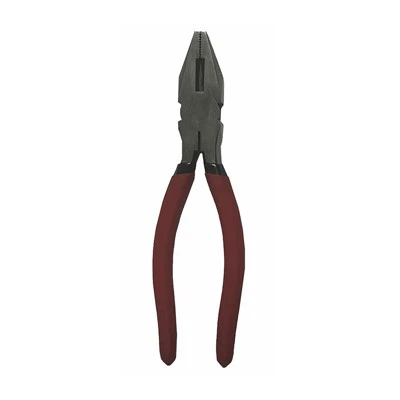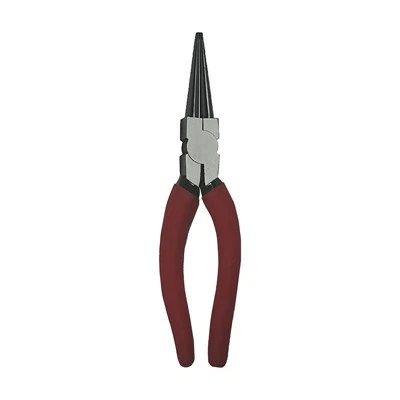Slip joint pliers are a versatile and essential tool in any toolkit, widely used in various industries and DIY projects. As a slip joint pliers supplier, I have in - depth knowledge of different types of slip joint pliers, their unique features, and their applications. This blog will introduce you to the major types of slip joint pliers, helping you understand which one is the right choice for your specific needs.
Standard Slip Joint Pliers
Standard slip joint pliers are the most common type. They have a simple yet effective design. The jaws of these pliers are flat and parallel, with serrated surfaces to provide a better grip on objects. The slip - joint mechanism allows the user to adjust the width of the jaws to accommodate different sizes of objects. This is done by moving the pivot point of the two handles, enabling the pliers to grip anything from small nails to larger pipes.
These pliers are widely used in general household repairs. For example, if you need to tighten or loosen a nut or bolt, standard slip joint pliers can do the job. They are also useful for gripping and holding various objects when working on DIY projects, such as woodworking or simple metalworking. The serrated jaws prevent the object from slipping out, ensuring a secure hold during the operation.
Tongue - and - Groove Pliers
Tongue - and - groove pliers, also known as Channellock pliers (a well - known brand name in this category), are characterized by a series of grooves on one jaw and a corresponding tongue on the other. This design allows for multiple adjustment settings, much more than standard slip joint pliers. The adjustment is precise, making it easy to grip objects of different sizes with a tight fit.
These pliers are often used in plumbing and automotive repairs. In plumbing, they can be used to grip and turn pipes of different diameters, and the strong grip can prevent damage to the pipes. In automotive work, they are useful for tasks like removing or installing hoses, as the adjustable and secure grip can hold the hose firmly without crushing it.
Needle - Nose Slip Joint Pliers
Needle - nose slip joint pliers have long, tapered jaws that come to a fine point. This design makes them ideal for working in tight spaces where standard pliers might not fit. The fine tips allow for precise gripping and manipulation of small objects, such as electronic components, jewelry pieces, or small wires.
In electronics repair, needle - nose slip joint pliers are essential for tasks like soldering. They can hold a small component in place while the user solders it onto a circuit board. In jewelry making, these pliers are used to bend and shape small wires and to pick up and place tiny beads. The slip - joint mechanism also allows for some adjustment of the jaw width, adding to their versatility.
Lineman's Pliers
Lineman's pliers are a heavy - duty type of slip joint pliers. They have a combination of features suitable for electrical work. The jaws have a cutting edge near the pivot, which can be used to cut through wires of various gauges. The rest of the jaws are serrated for gripping.
Electricians rely on lineman's pliers for a wide range of tasks. When installing electrical systems, they use these pliers to cut and strip wires, as well as to twist and connect wires together. The gripping force of the serrated jaws is strong enough to hold thick wires firmly in place during these operations. The cutting edge is designed to make clean cuts, preventing fraying of the wires.
Locking Slip Joint Pliers
Locking slip joint pliers, also known as Vise - Grips, are unique in that they can be locked in a set position. Once the jaws are adjusted to the desired width around an object, a locking mechanism can be engaged to hold the pliers in place. This frees up the user's hands, which can be very useful in situations where continuous pressure needs to be applied or when both hands are required for other tasks.
In metalworking or welding projects, locking slip joint pliers can be used to hold two pieces of metal together while they are being joined. They can also be used in plumbing as a temporary clamp around a pipe to prevent water leakage during repairs. The ability to lock the pliers in place provides a high level of stability and precision during the operation.
Diagonal - Cutting Slip Joint Pliers
Diagonal - cutting slip joint pliers are designed specifically for cutting wires and small metal objects. The jaws are shaped like scissors, with a sharp cutting edge that meets at a diagonal angle. The slip - joint mechanism allows for adjustment to handle different thicknesses of wires.


These pliers are commonly used in electrical work, wiring installations, and jewelry making. In electrical work, they are used to cut through electrical wires, and the sharp diagonal cut ensures a clean break. In jewelry making, they can be used to cut wire for creating necklaces, bracelets, and other jewelry pieces. For more details about this type, you can visit American Type Diagonal Cutting Pliers.
Long - Nose Slip Joint Pliers (American Type)
American Type Long Nose Pliers are similar to needle - nose pliers but with slightly different dimensions and applications. They have longer and more robust jaws compared to needle - nose pliers. This makes them suitable for tasks that require a bit more strength and reach, while still maintaining the ability to work in relatively tight spaces.
In construction and mechanical work, these pliers can be used to reach into hard - to - access areas to grip and bend wires or small metal parts. They are also useful in general metalworking when precise manipulation and moderate gripping force are needed.
Tower Pincer Pliers
Tower Pincer Plier is a specialized type of slip joint pliers. They often have a unique shape and design that is tailored for specific tasks. The exact features and applications can vary depending on the design, but they are generally used in situations where a more targeted or delicate grip is required.
For example, in some industrial assembly processes where small parts need to be carefully positioned and held, tower pincer pliers can be very useful. Their design may allow for better access to certain components and a more controlled grip compared to standard pliers.
In conclusion, the different types of slip joint pliers each have their own unique features and applications. As a slip joint pliers supplier, I understand the importance of having the right tool for the job. Whether you are a professional tradesperson or a DIY enthusiast, choosing the appropriate type of slip joint pliers can make your work much easier and more efficient.
If you are interested in purchasing high - quality slip joint pliers for your specific needs, please feel free to get in touch with our sales team. We can provide you with detailed information about our products, help you choose the right type of pliers, and discuss the best solutions for your requirements. Start a procurement negotiation today and let us help you solve your tool needs.
References
- "Handbook of Tools and Materials for Engineering and Construction." John Wiley & Sons, Inc.
- Industry standards and technical documents related to slip joint pliers manufacturing.





